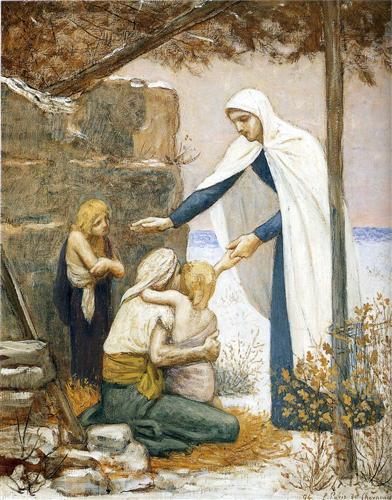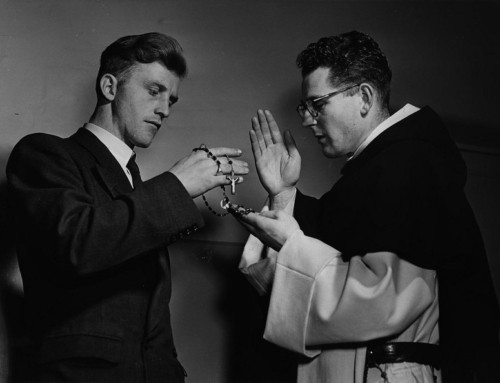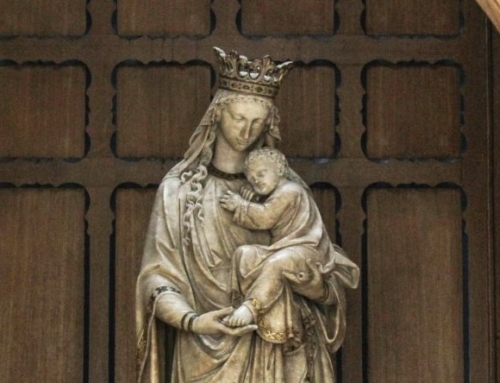Why we tell stories
We can consider conversions in the abstract, but they do not occur that way—they are concrete, life-changing experiences in a person’s story. Blessed Teresa of Calcutta said, “I look at the individual. I can only love one person at a time—just one, one, one. So you begin. I began—I picked up one person. Maybe if I didn’t pick up that one person, I wouldn’t have picked up forty-two thousand.”
Since their founding in 1950 by Mother Teresa, the Missionaries of Charity have expanded by thousands across the globe into every nook and cranny of the world’s inner cities. Much can be said in broad terms of their unique mission in the Church, caring for the souls of the “poorest of the poor.” Perhaps a better approach is to tell stories. Individual stories capture life on an individual basis, where conversion happens. They also offer a glimpse of the sisters themselves, who stand out conspicuously in photographs or as they stroll down a street in white and blue Indian saris, yet whose true marks are their humor, beauty, and holiness.
Sisters of New York
One source of these stories is a long-time volunteer for the sisters in New York City. He wishes here to remain anonymous, yet he is omnipresent to their houses and known by all who have likewise volunteered there. Earlier this year I crossed paths with him at the convent in Harlem, and the sisters smiled at his arrival, saying, “We say that he owns the house. He owns every house.” His stories begin with the sisters’ first arrival to the city in 1971.
“My father was in the bar business. He owned thirty-two bars in Harlem. When I graduated college in 1955, I owned three bars myself. I’ve known over one hundred men murdered, who used to come to the bar. It’s a crazy world. But many of the guys from the bar, I’d see thirty years later at the soup kitchen.” As soon as the sisters had moved into the New York neighborhoods—some of the most dangerous in the Bronx and Harlem—he and other lay volunteers were at their side. “None of us could go in there alone, but the sisters immediately had the respect of the people. Because everybody knows they’ve come to help. They recognize immediately that they’re women of God.” He adds, “The men from the street especially respect the sisters. Many of them were raised by their mothers, and in their mind, any woman who feeds you, that’s a good woman!” It was not only the foreign dress and the smiling faces which ingratiated the sisters to the new neighbors, but the holiness of their hands, which they used to feed the people in their basic needs. Another brother recounts a Eucharistic procession through the Bronx, when the sisters began yelling up to people in their apartments to turn the radios off. And they all obeyed!
These acts, however, are always accompanied by the Gospel. In their soup kitchens, the sisters have a policy of singing a hymn with the guests and reading Scripture before the meal. “In Harlem there was a Muslim man who would come in and listen to the readings every day. Soon he stopped showing up and was gone for years. Then one day he comes in and says, ‘I want to be baptized a Catholic.’ It turns out he had stage IV cancer. So the sisters had him baptized by a priest in the Bronx, whom he formed a close relationship with. He still comes by the kitchen, saying that his faith keeps him going.”
In 1985, years after their arrival in the north part of the city, the sisters founded a new house—Gift of Love—in the West Village. Mother Teresa wanted to respond to the growing AIDS crisis and opened a hospice for these victims, the first of its kind in the world. My anonymous source continues, “I didn’t tell anyone I was working there, not my friends or co-workers, but only my immediate family. At the time, doctors couldn’t even tell you whether or not you were vulnerable to getting the virus through a mosquito bite—the disease was still uncharted territory. That’s the risk we took. But the sisters were wonderful with it! Many people were saying how difficult that kind of work would be, how we would get depressed after a few years, etc. But it was more rewarding than anything else we did! People come and go at the shelters, but in that work you got to see your reward, as you saw each person go to heaven. In the first five to seven years of opening, we didn’t lose a single one of the men without them getting a priest and getting baptized.”
In their care for the poor, the sisters would offer baptism for the people under their care, while always respecting their free choice. Some patients would agree to the offer, then later flee when the time came. One man had agreed to the invitation, so the sisters bought him a suit and set a date for the baptism. Every time it came around though, he would go missing, and after three or four tries he finally disappeared. “He was gone for almost twenty years, then one day he showed up again. Would you believe it, he had been baptized in jail, but by now he had full blown AIDS and was dying. He had come back to ask the sisters if he could give their phone number in case anything happened to him. They said he could, and when he died soon after, they did everything for him: called together his family, had a funeral Mass, buried him, everything.”
Another story tells of the sisters’ persistence in never letting someone out of their sight. “Every evening before dinner, the sisters would pray the rosary with the men and discuss Scripture. Well this one guy, with no religion, when he heard Jesus say to forgive your brother seventy times seven—well, he flipped out! He just couldn’t believe it! We didn’t see him for years, but one day, the sisters found out he was dying in Harlem Hospital. So they found a priest and went and tracked him down. He asked to be baptized, and he had such joy the moment it was happening, that he started having diarrhea. But the priest kept right on with it, saying to him, ‘Don’t worry about it, you’re doing fine.’ He didn’t miss a beat!”
Serving Changes Us
Those who lay down their lives in service to the Church hope that their work will change other lives. Yet Christ promises change to the giver as well. “Whoever would save his life will lose it, and whoever loses his life for my sake will find it” (Mt 16:25). Yet this truth often rebounds off of our ears, not making sense to our usual way of thinking. Nonetheless, it finds its affirmation as it is lived out, as something tasted in the efforts of those who love Christ and love others for His sake. All who find Christ find true life. And those who give their lives to His work in the world begin to find joy in the work and begin to “find themselves,” to put it colloquially.
Many who hear of the Missionaries’ lifestyle are shocked by their austerities: they own nothing but their simple clothing; they spend all day in work or prayer; they are sent across the world to serve, multiple times over; they visit their families once every ten years; they eat, pray, and sleep on the floor; they do not even have pockets! But the impression one gets from meeting the sisters in person is far different: it is one bursting with the joy of living for Christ.
A few summers ago, a group of Dominican brothers and I were privileged to work with the sisters in New York. Trying to enter into their routine is a lesson in delightful chaos, where the only plan is “whatever happens, happens.” The first sister I met at the soup kitchen lost her sandal as she opened the door, and then began laughing at herself while gesturing for us to enter. Ten minutes later, fifty homeless people from the street entered the dining room, and a sister smiled at me and said, “You are a Dominican. Preach to them!” “How long,” I asked. “I don’t know how long,” she said. And when that was finally over, a whirl of serving, dishwashing, and chatter commenced. A fellow brother recounts an early conversation with one of the sisters that summer: “You know what MC stands for, Brother? Much confusion!” Then she laughed. All MCs laugh when the subject comes up; they candidly admit that part of their charism is to be organizationally challenged. And that is how God uses you for the Gospel!
The rest of the summer was an ongoing lesson about how many lives the sisters touch on a weekly basis: teaching children music and catechesis at summer camp; playing soccer at summer camp and not taking it easy on the boys; walking into homeless tent villages with sandwiches and giant pitchers of orange Tang; visiting shut-in couples in their apartments, hearing about their grandchildren or singing old songs with them in their own dialects; or planning a trip to the beach for the homeless, then enlisting the help of the lifeguards to lead a blind man into the waves so that he could sit in shallow water and let it wash over him. The main reason why the sisters reach so many lives is simple: they just go! They neither wait for the plan to be perfect nor reevaluate every factor. Whether it is in the chapel or the street, the sisters place a high value on just showing up, then letting the Lord do the rest.
It was not only the poor who were changed that summer. My own life was changed. By the end of the summer, I was no longer uncomfortable with the poor, but I had learned from the sisters how to approach them with confidence and the importance of simply asking their name. Mother Teresa knew our job as Christians was not to change the whole world, but simply to show love wherever we are in that world, to any given person on any given day: “We ourselves feel that what we are doing is just a drop in the ocean. But if that drop was not in the ocean, I think the ocean would be less because of that missing drop. I do not agree with the big way of doing things. . . . If we wait till we get the numbers, then we will be lost in the numbers. And we will never be able to show that love and respect for the person. I believe in person to person; every person is Christ for me, and since there is only one Jesus, that person is the one person in the world at that moment.”
It is not only the poor who are changed, or even the volunteers who help the sisters. In time, you begin to hear the sisters talk about how they have changed. One sister, after spending many years working with children, was assigned to an AIDS hospice. She recalled her first time with a woman moments away from death; she was afraid to look into the dying woman’s eyes. So instead she sat by her head and looked in the direction of the woman’s feet! In a moment, however, she knew that what the woman needed most was someone to be with her and to look at her, face to face. So she did, and the moment was instead very beautiful. She has not been afraid ever since.
Such is the strange beauty of these houses. Patients from across the globe arrive as total strangers, as persons following just another reference. Those who die, die in the care of women they hardly know; they die holding the hands of women who love them so that in their final moments they might know they are someone. Many live a long while and end up becoming proverbial members of the family—an Asian businessman, bankrupt after he contracted the disease; an old Haitian man who lost his family in the earthquake; others who had spent their lives on drugs or the gay scene right down the street. The sisters feed them, clean for them, bring them to Mass; and many have even entered the Catholic Church. Yet all is joy, and the jokes are constant, as the message on the sisters’ faces is clear: they truly love the people they serve.
Joy Within, Joy Without
It is surprising to see such joy and hilarity among sisters with such serious work. Yes, their life is difficult. They repeated to us many times, “Being an MC is very difficult, Brother.” Many wrongly assume the sisters are referring to their constant work with the poor. True, they work and pray non-stop. In addition, situations often grow overwhelming to the untrained spectator: I remember attending a party they had for hundreds of guests, while starting a Holy Hour right across the hall at the same time. I also cannot forget the field trip we took with a bus full of children, forgetting to give the bus driver directions, then getting horribly lost, and feverishly reciting the Memorare. The driver soon found the way, and only ten minutes late! But MCs thrive on this routine. They laugh it all off. What is most difficult, they will tell you, is living together. Like the rest of us, love of neighbor is easy with strangers, but seemingly impossible at home.
Thus, Mother Teresa’s insistence that love must begin at home strikes to the heart of the Christian vocation. We can only love if we have been loved first (1 Jn 4:10). Forgiveness is divine, and it comes to us only by first receiving God’s love. For the MCs, He also loves them through the poor, as they love the poor. This becomes fuel for their life at home. Mother Teresa always exclaimed that the poor teach us more than we teach them. Once we see beneath their “distressing disguise” to the real and living and beautiful person within, we bring our discovery home. We learn to recognize what is underneath the conflicts we have with one another, because like the poor, we all wear a “distressing disguise” to cover our own loneliness, our fears, and our hunger for love. Only then can we look with love on one another, and so continue in God’s ways for us, full of newfound joy.
There is only one source of joy: it is the effect of being in love with God. But no Christian life on earth is one of uninterrupted joy. I have heard MCs repeat many times, “We have a simple teaching, but it is very hard to live.” And that simple teaching is to love all people as Christ. Yet just as brothers and sisters can be crosses for one another, they are ironically blessings as well—we only survive because we do not live alone. Even Mother Teresa stood in need as she endured long periods of darkness: “As for myself… I have nothing to say—for the darkness is so dark, the pain is so painful. Sometimes the grip of pain is so great—that I can hear my own voice call out—My God, help me. When I help the Sisters draw very close to Jesus—when I teach them to love Him with a deep—devoted—personal love—I long to be able to do the same. —The Sisters in front of my very eyes I see them love God—come so close to Him—grow daily so much like Him… I am happy to see Him loved—to see the Sisters grow like Him. I am happy to love Him through them.” While their founder floundered in the dark night of faith, her joy was to see their joy. She was a silent sufferer for her sisters, and they were her joyful offering to God. Christ knows that the way to holiness is difficult for us, and He does not call us to journey alone. He calls us as a community, shouldering each other’s burdens, as we plod the path towards the joy that awaits us. As the anonymous volunteer above testifies after many years, “Really when you see the sisters, you see Mother. So many of them knew her firsthand, and they really emulate her. It’s amazing to see.”
Epilogue
There is no proper way to conclude a collection of stories and experiences. By their nature, they speak for themselves and leave us with resounding impressions far better than any summary could achieve. In light of this, I will finish with one last story, as a testimony to the Missionaries of Charity and their gift of joy to the world.
Two years ago I was returning from a Christmas visit to my family in Phoenix. I sat in the airport terminal at 6 A.M. feeling miserable: my family had had another fight; I was going through a patch of confusion and temptation; in my spirit I wrestled God over the burden of my vocation, saying to myself, “What good am I even doing anyway?” As I sat there, forcing my way through the psalms of Morning Prayer, two short, happy Missionaries of Charity walked across my path. They appeared confused about Southwest boarding policies, looking around for assistance. So I introduced myself and asked whether they were in group A or B? One replied, “I’m in S group, for Sister Susan.” I smiled and explained the boarding policies—it turned out they were in group B—and when I returned to my seat, my storm had been stilled to a “great calm” (Mt 8:26).
An hour later during my flight, I came to the last page of the novel I had been reading all week, Deep River by Shusaku Endo. The main character, a Japanese woman visiting India, is waiting to board her flight home and going through a crisis of faith. Out of the crowd emerge two Missionaries of Charity to carry off a dying person in the street—now they walked into my novel! I proceeded to fling my book against the passenger window—give the shock its due—then resumed reading. The character interrupts them and asks why they are helping that person: “The nun opened her blue eyes wide and stared at Mitsuko. ‘Why are you doing this?’ Her eyes still brimming with surprise, the nun slowly answered. ‘Because, except for this… there is nothing in this world we can believe in.’”
We cannot solve all the evils of the world. We cannot even hold ourselves together in the daily demands of life without the grace of God. We are called to show love to the people three feet in front of us. Love of neighbor is not one of many options in living the Christian life; rather, “there is nothing else in this world.” Nor is it a unique charism reserved for the Missionaries of Charity—though they do it with a unique sort of flair, let us say. They remind us that there is no other way to live. We have only to begin right where we are: “Stay where you are. Find your own Calcutta. Find the sick, the suffering, and the lonely right there where you are—in your own homes and in your own families, in your workplaces and in your schools. You can find Calcutta all over the world, if you have the eyes to see.”
Whoever we are, wherever we are, we too must write our own stories. Rather, we must hand over the pencil to God and agree to play the main character from now on, not the author. He does not promise it will be easy, but it will be a good story. We will be happy, journeying together. And we will arrive at home, having tasted the goodness of the Lord all our lives long.
To download a printable PDF of this Article from
Dominicana Journal, Summer 2015, Vol LVIII, No. 1, CLICK HERE.




